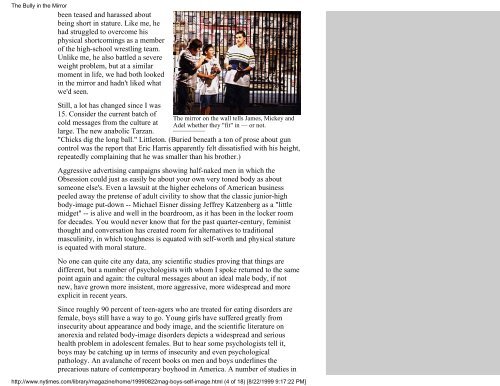The New York Times Magazine, Sunday, August 22, 1999
The New York Times Magazine, Sunday, August 22, 1999
The New York Times Magazine, Sunday, August 22, 1999
Create successful ePaper yourself
Turn your PDF publications into a flip-book with our unique Google optimized e-Paper software.
<strong>The</strong> Bully in the Mirror<br />
been teased and harassed about<br />
being short in stature. Like me, he<br />
had struggled to overcome his<br />
physical shortcomings as a member<br />
of the high-school wrestling team.<br />
Unlike me, he also battled a severe<br />
weight problem, but at a similar<br />
moment in life, we had both looked<br />
in the mirror and hadn't liked what<br />
we'd seen.<br />
Still, a lot has changed since I was<br />
15. Consider the current batch of<br />
cold messages from the culture at<br />
large. <strong>The</strong> new anabolic Tarzan.<br />
<strong>The</strong> mirror on the wall tells James, Mickey and<br />
Adel whether they "fit" in — or not.<br />
"Chicks dig the long ball." Littleton. (Buried beneath a ton of prose about gun<br />
control was the report that Eric Harris apparently felt dissatisfied with his height,<br />
repeatedly complaining that he was smaller than his brother.)<br />
Aggressive advertising campaigns showing half-naked men in which the<br />
Obsession could just as easily be about your own very toned body as about<br />
someone else's. Even a lawsuit at the higher echelons of American business<br />
peeled away the pretense of adult civility to show that the classic junior-high<br />
body-image put-down -- Michael Eisner dissing Jeffrey Katzenberg as a "little<br />
midget" -- is alive and well in the boardroom, as it has been in the locker room<br />
for decades. You would never know that for the past quarter-century, feminist<br />
thought and conversation has created room for alternatives to traditional<br />
masculinity, in which toughness is equated with self-worth and physical stature<br />
is equated with moral stature.<br />
No one can quite cite any data, any scientific studies proving that things are<br />
different, but a number of psychologists with whom I spoke returned to the same<br />
point again and again: the cultural messages about an ideal male body, if not<br />
new, have grown more insistent, more aggressive, more widespread and more<br />
explicit in recent years.<br />
Since roughly 90 percent of teen-agers who are treated for eating disorders are<br />
female, boys still have a way to go. Young girls have suffered greatly from<br />
insecurity about appearance and body image, and the scientific literature on<br />
anorexia and related body-image disorders depicts a widespread and serious<br />
health problem in adolescent females. But to hear some psychologists tell it,<br />
boys may be catching up in terms of insecurity and even psychological<br />
pathology. An avalanche of recent books on men and boys underlines the<br />
precarious nature of contemporary boyhood in America. A number of studies in<br />
http://www.nytimes.com/library/magazine/home/<strong>1999</strong>08<strong>22</strong>mag-boys-self-image.html (4 of 18) [8/<strong>22</strong>/<strong>1999</strong> 9:17:<strong>22</strong> PM]






